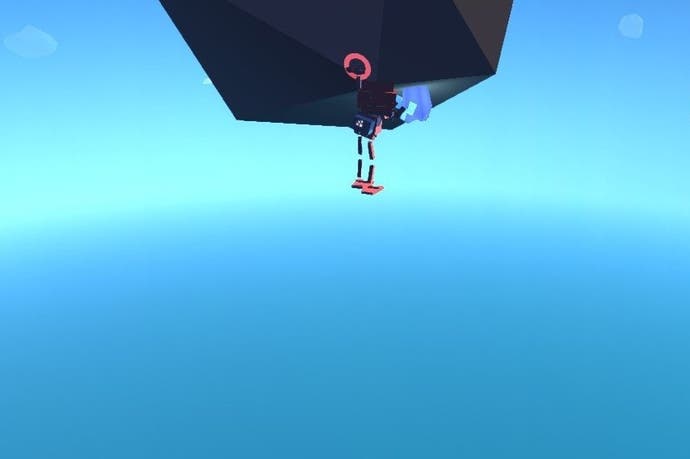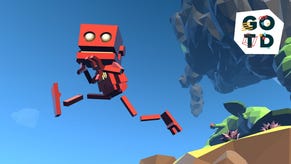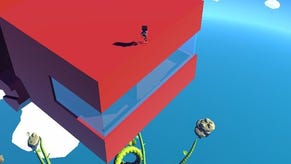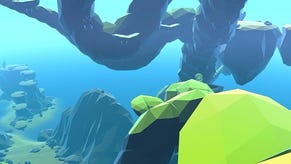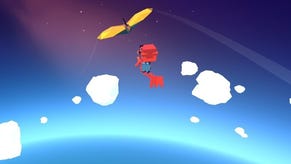Grow Home and the pleasures of a world you can touch
Vineland.
If you play enough first-person shooters, something really weird can set in from time to time - something strangely off-putting. In certain games the depth of the environment can drop away after a while, the world steadily losing its tangibility, and you start to realise that, underneath everything - or maybe somehow above everything - you're just a reticule scudding over the screen, roving and hovering and blasting.
It's so odd when this happens - when a rich 3D world suddenly becomes entirely 2D, when the animations become little more than dressings for hit boxes, when you realise that you are little more than a deadly camera passing across the environment from a polite and uncrossable distance. It's not only first-person games, either. The original Mercenaries, good as it was, could often turn into a reticule experience. Even the first Uncharted did it on occasion.
This probably helps explain why developers spend such a lot of time laying on little elements that draw you back into the fiction of the world - back into the fiction that there is a world in the first place. Here's your hand working away during a reload. Here's a little bit of motion blur as you turn. Here's splattered blood or splintered light playing against the lens of the game, to suggest to you that there is a lens - not that this would make it any more real, of course, but for video games realism must be approached from a jaunty angle - and that there is a landscape beyond the lens.
And perhaps it also explains why I'm going to spend this Saturday in the garden. Not my own garden, which is damp and spidery and riddled with things that can't wait to give me splinters. I'm going to spend it in the garden that is Grow Home, a game where there is no reticule, and where there is absolutely no danger at all of the flattening effect taking hold.
You can complete Grow Home in an afternoon. I have, in fact. And yet on Steam, my in-game clock reads 20 hours and I'm still putting in a few extra minutes every week. I've nabbed all the crystals. I've nabbed all the plants. I've nabbed almost all of the achievements, save the mushroom-bouncing one which is just too hard to be doing with and the meep-drowning one which is just too cruel. Even so, here I am again, with nothing, technically speaking, left to do but so much to keep me playing. A while back, with the game's PSN release visible in the distance - it's out right now and it's free if you have PlayStation Plus - I wanted to get a sense of what makes this strange game so endlessly appealing to me. Over Skype, I chatted to one of the developers for a few minutes, and it turned out that most of what we had to talk about was the reticule problem, the flattening effect, the difficulties in creating a game that never holds you at a distance.
Grow Home, just to give you a bit of context, is a bright, colourful thing in which you play a dinky red robot who's exploring a beautiful alien world, clambering over rocks and slowly nursing a beanstalk up from the sandy beach where it's sprouted and high into the sky, past floating islands and asteroids until it reaches your chunky red rocketship, idling in noble orbit.
And everything in the game sprang from the dinky red robot. "It started with some guys just experimenting around between projects, playing with a bit of technology," explains designer Andrew Willans, who is now at CCP. "That's where the first procedural animation toy came about. So we pulled together a team, and we asked: can we take this toy and turn it into a game? Can we do something with this? There was a bit of charm in it. The way the character moved. There was something that just felt right. And that's the root of where it comes from."
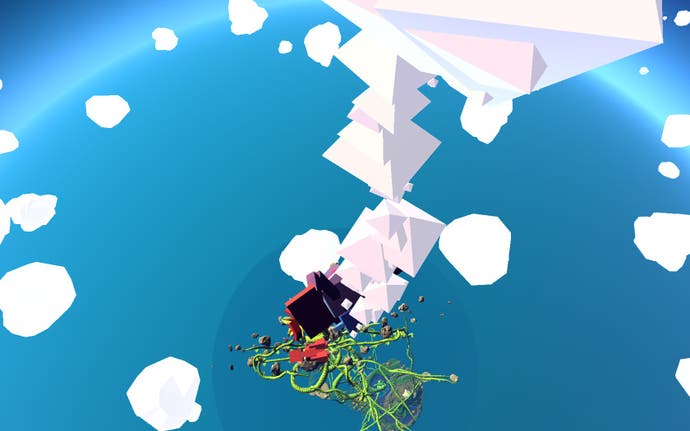
The robot - or BUD as he's known - is entirely physics-driven. "It's all held together by physical forces and different equations to move the body and the limbs," says Willans. "Essentially, he's standing on two forces, and trying to maintain his balance at all times on these." This doesn't just allow players to inhabit the body of a playful, knockabout character who's always moving in an amusing manner. It also suggested the kind of game that should be built around him. A huge part of the reason that Grow Home is so enduringly satisfying, Willans tells me, is because the world and the character that inhabits it are truly made for each other.
This is where Grow Home's greatest joy came from, in fact: reaching out and grabbing the landscape in order to climb it. "We had a lot of objects in the world where BUD could just grab them and pick them up," Willans says. "The side effect of that was the fact that you did just climb up things. On any surface you could just use your hands - it was like two independent inputs - and you could transfer your weight. You'll notice this a lot in the game: you can stretch to go further, you can do shorter grabs."
Internally, competition soon took hold. "We built a climbing wall," Willans laughs. "and it was just a series of these rocks. We called it a six stack challenge. Once people started setting the right times we realised: oh, there's actually a lot of depth to the climbing. There were people who were using the bumpers and really going quick, hand over hand. Then there were other people - myself included - I tend to put both hands on, pull my weight back and almost catapult myself up, that Tom Cruise-style thing from Mission Impossible."

The final element was the beanstalk: a clear, tangible, meaningful progression system for players, and also a chance for them to handle some of the actual design of the landscape themselves. Grow Home feels a lot like Mario 64 at times - that sense that the world has been built around the character also means that the environment seems more like a place in its own right than a set of levels where managed fun has to be carefully arranged and riddled with triggers - but it goes even further when it comes to that beanstalk. This is a Mario 64 in which Nintendo has allowed you to get your hands dirty at the design stage.
It's all about getting your hands dirty, really: a world built to be clambered over and grabbed at, pulled around and manipulated. It's a game about touch, from the way you heft the glowing crystal collectibles right out of the rock you find them in as if you're yanking teeth, to the way you hold on tight while you steer a creaking, bucking beanstalk through the sky en route to your next adventure.
Tactility gives the game a great integrity - so much so that Willans and his team decided that if you dropped a vital object into the sea while playing, it wouldn't regenerate in an artificial manner, but would instead wash up on what the developers termed The Magic Beach - and also allows it to keep you involved moment to moment. Compare the hand-over-hand climbing of Grow Home to the point-and-push parkour of Assassin's Creed. Grow Home's slower and less obviously cinematic, perhaps, but each moment becomes part of an unfolding set-piece. You're right there, touching the game, and you can't afford to look away.
This afternoon was a case in point. Over the course of writing this, I've spent a couple of mindless hours in Willan's game teasing a creeper down from the very depths of space and back to the beach where I first landed. That's quite a journey, and it goes without saying that there wasn't very much in the way of a clear reason to undertake it. There isn't much in the way of a clear reason to undertake anything in Grow Home by this point, and yet I'm still in there because I'm still in there, deep beneath the glass, far beyond the screen.
